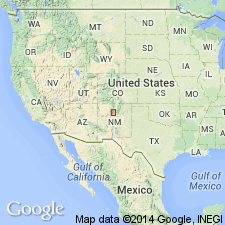
- Usage in publication:
-
- Canovas Canyon Rhyolite*
- Modifications:
-
- Original reference
- Dominant lithology:
-
- Rhyolite
- AAPG geologic province:
-
- San Juan basin
Summary:
Pg. P5-P6. Canovas Canyon Rhyolite of Keres Group. In Bear Springs area consists of alternating bedded tuffs, massive pumice breccias, and lava flows, which are locally intruded by small rhyolite bodies; maximum thickness 900 feet. Overlies Santa Fe Formation. A few miles to west, on Borrega Mesa, overlies basalt of Chamisa Mesa (Keres Group), interfingers with Cochiti Formation, and conformably underlies Paliza Canyon Formation (Keres Group). Age is probably early Pliocene, [based on stratigraphic position].
[Type locality:] Bear Springs Peak, [Santa Fe National Forest, in SE/4 sec. 30, T. 17 N., R. 4 E., Bear Springs Peak 7.5-min quadrangle], Sandoval Co., north-central NM. Named from nearby Canovas Canyon where unit is also exposed.
Source: Publication; US geologic names lexicon (USGS Bull. 1520, p. 50).
For more information, please contact Nancy Stamm, Geologic Names Committee Secretary.
Asterisk (*) indicates published by U.S. Geological Survey authors.
"No current usage" (†) implies that a name has been abandoned or has fallen into disuse. Former usage and, if known, replacement name given in parentheses ( ).
Slash (/) indicates name conflicts with nomenclatural guidelines (CSN, 1933; ACSN, 1961, 1970; NACSN, 1983, 2005, 2021). May be explained within brackets ([ ]).

